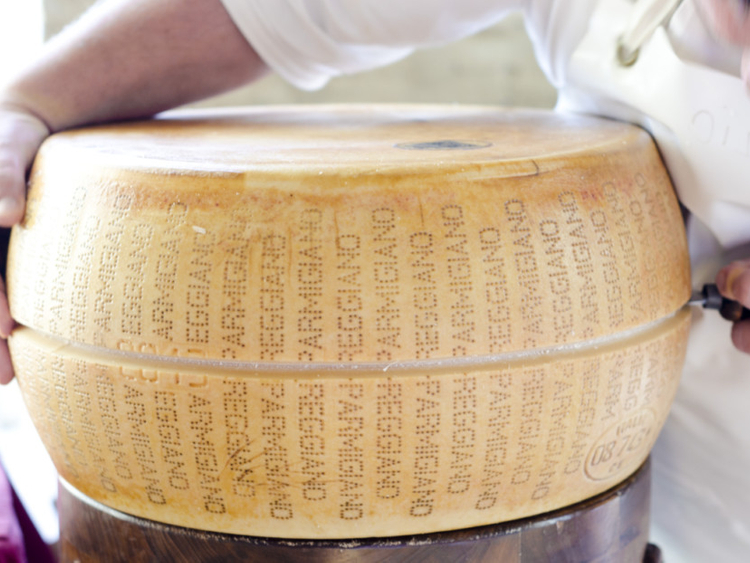
Dubai
How do you eat your cheese? If you’ve been having it straight out of the refrigerator, well, you don’t know your chalk from cheese.
“One of the most common mistakes when it comes to cheese is that people don’t eat it at room temperature,” says Fabrizio Raimondi of Italy’s Parmigiano Reggiano, the nine-centuries old cheese, known to be one of the most ancient and richest in the world.
With the Parmigiano Reggiano Consortium, which comprises 335 Parmigiano Reggiano producers, identifying the UAE as one of its main markets, Raimondi is out to educate consumers here on the whats, whys, whens and hows of cheese.
Ask him what cheese actually is and you will be surprised to know it is a legally defined product. “According to the Italian law (Royal Decree No 2033 of 1925), cheese is the product obtained from whole or partly skimmed milk, or from cream, after coagulation by acidification or by renneting, also using starter bacteria or kitchen salt,” says Raimondi.
There’s no guessing when it comes to the different kinds of cheese. Going by what Clal, the Italian Dairy Economic Consulting firm’s analysis of the dairy market, Raimondi says, “Cheeses are classified on the basis of a series of parameters: type of milk employed, fat content, consistency, moisture level, technology adopted and temperature of curd processing, duration of ripening and denomination.”
Host of varieties
Each of these parameters lends itself to a host of varieties. For example, depending on the milk employed, cheese can be classified as cow, ewe’s, buffalo and goat cheese.
In terms of consistency, cheeses like Robiola, Quartirolo, Stracchino, Crescenza, Mozzarella, Burrata, Gorgonzola, Caprini, Casatella and Squacquerone are soft cheeses as they have a moisture content of over 45 per cent. These cheeses may have a rind (like Taleggio) or not have one (like Pannerone).
According to Raimondi, cheeses like Ragusano, Asiago, Bitto, Fontina, Bra, Castelmagno and Italico are semi-hard with a moisture content of 35-45 per cent while Grana Padano, Parmigiano-Reggiano, Pecorino Romano, Montasio, Pecorino Sardo and Fiore Sardo are of the hard variety, as their water levels are below 35 per cent.
The processing technology determines whether the cheese is raw (Robiola, Mozzarella, Crescenza, Gorgonzola etc), semi-cooked where the curd is cooked at 48°C (Asiago, Fontina, Italico etc), cooked where the curd is cooked at over 48°C (Grana Padano, Parmigiano-Reggiano, Montasio, Bitto etc), molded (or “blue”) where the cheese is obtained from milk intentionally inoculated with mold spores which grow inside the cheese body and help ripen it through specific enzymatic activities (Gorgonzola, Castelmagno etc).
Similarly, the duration of ripening determines whether the cheese is fresh, short, medium or long ripened. Fresh cheese like Mozzarella, Fiordilatte, Crescenza, Casatella must be consumed within a few days as there is no ripening here and the cheese has no rind or superficial microflora.
But how can you tell if the cheese is fresh? “Cheese can be tricky sometimes. You can tell if your cheese is fresh by focusing on three elements: smell, appearance (colour, texture) and taste.
As it turns out, the type of cheese also dictates how it should be eaten. “Take Parmigiano Reggiano for instance. After purchasing a piece of freshly cut cheese or taking one out of a vacuum pack, it must be stored in the refrigerator at a temperature between 4 and 8ºC . Also, if it is in a vacuum pack it is necessary to open it at least 30 minutes before consumption. It must also be noted that in ventilated refrigerators, cheese tends to dry and the fatty part of the cheese tends to absorb other smells present in the fridge. So the cheese must be stored in appropriate glass or plastic containers. Another very practical solution is wrapping it in food-grade plastic film. The cheese should never be frozen just as it must never be eaten straight out of the refrigerator.”












